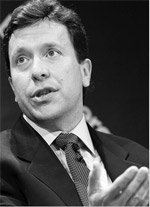
Categories
Resource Links
 GIR's Investing in the New Europe
GIR's Investing in the New EuropeBloomberg Press, 2001, "Sound, practical advice."
Wall Street Journal Europe
RELATIVE VALUE ADVOCATE SHOWS STRATEGY’S WORTH
27 September 2010, Financial Times
In its heyday, Long Term Capital Management was considered the top player in relative value. In summer 1998, it was being watched closely by Bob Treue, a fellow practitioner of this hedge fund strategy that exploits the mispricing of one asset relative to another comparable one.

Bob Treue made sure he had enough collateral (Bloomberg)
He was head trader of fixed income relative value at London-based Paloma Partners at the time, and one investment that intrigued him appeared to be based on the emerging euro.
As companies across the 11 original eurozone markets were preparing for the introduction of the common currency, there was a surge in demand to convert legacy bank notes into euros. The preset exchange rate of a basket of constituent currencies – as of January 1 1999 – was $1.16. However, demand was pushing the euro’s value as high as $1.182 just months before the changeover. This meant going long the constituent currencies (betting that they would increase in value) and short the euro (betting that it would fall in value) was a pretty sure play.
But LTCM blew up before profits were realised because it was overborrowed and could not sustain positions that were moving the wrong way. To Mr Treue, the lesson of LTCM was best summed up by the maxim attributed to Keynes: the market can stay irrational longer than you can stay solvent.
So in setting up Barnegat, his own fixed income relative value hedge fund, in 2001, Mr Treue made sure of doing two things: investing in clearly mispriced securities that would correct; and having sufficient collateral to ensure the ability to wait out the correction.
To be able to hold on long enough he keeps 40-50 per cent of the fund’s capital as collateral. And he relies on leverage to boost exposure – 10 times as of the end of 2009. For nearly a decade, his execution has been virtually spot on.
Since inception, Barnegat has achieved annualised returns of 18.4 per cent to end August 2010, outperforming developed and emerging equity and bond markets, along with fixed income arbitrage and broad hedge fund indices. Only in two years did he trail returns of the Dow Jones Credit Suisse Blue Chip Hedge Fund Index and the S&P 500. While his 37.6 per cent loss in 2008 was in line with stock and relative value hedge fund performances, sustained exposure to most of these positions that were down subsequently led to a 132.7 per cent surge in 2009. And so far this year, while the market and most hedge funds have struggled, he is up nearly 16 per cent to August.
Despite the apparent soundness of his strategy, Mr Treue’s success was far from assured when he first started out. He was working out of the New York Public Library where access to the free Bloomberg was restricted to two hours, with his investments funded solely from his limited savings.
But he made quick believers out of the two funds of hedge funds and one global pension fund that put up the fund’s initial $25m in early 2001. While the S&P 500 fell more than 16 per cent that year, Mr Treue gained 13.5 per cent.
The following year, during the height of the sell-off, when stocks lost nearly one-quarter of their value, Barnegat soared by nearly 56 per cent. And the manager proceeded to turn in gains every year until 2008.
“That year was the only time I ever sold out of positions before I realised gains,” says Mr Treue, “but I did this to control risk as volatility was going off the charts – not because our investments lost their reason.”
Save for selling out entirely of his Norwegian interest rate swaps, Mr Treue simply pared back his 17 other positions. This set the stage for gains of nearly 133 per cent in 2009.
One of his most successful plays at the time involved US Treasury Inflation Protected Securities and Treasuries of the same duration. Because of Lehman’s extensive use of Tips for collateral in its repo trades, its bankruptcy in autumn 2008 resulted in massive liquidation of Tips, sending their prices lower and yields higher. The six year Tips hit 5 per cent while the nominal Treasury yields were half that.
Mr Treue profited by going long Tips and short Treasuries and waiting for the prices to converge.
UK quantitative easing offered another opportunity, producing a kink in the yield curve where four-year gilts were yielding 3 per cent and five-year gilts were paying 2.8 per cent. Mr Treue went long the four year bonds, and short five year bonds. When the Bank suspended quantitative easing a year later in March 2010, both gilts corrected in his favour.
“Barnegat has proven itself over several market cycles,” says Jonathan Kanterman, a managing director at Stillwater Capital, a fund of hedge funds that is not invested in the fund. He thinks Mr Treue knows his field and how to apply his strategy, especially in managing leverage to enhance exposure that is limited due to his high levels of collateral. But what especially caught Mr Kanterman’s notice was Mr Treue’s counterparty contracts, the terms of which have helped protect his positions.
Success has pushed Barnegat’s assets up to $450m, but Mr Treue maintains his modest work and life styles. He lives in Hoboken, New Jersey, biking between his apartment and office, and managing with six staff and relatively modest fees of 1 and 15 percent.
Tags: Argonaut, Balestra Capital, Barnegat Fund, Closed-end funds, Commodity Trading Advisors, Finisterre, Global macro, Hedge funds, mutual funds, Partners, Risk management, Xerion Fund
This entry was posted on Monday, September 27th, 2010 at 7:09 pm and is filed under FUNDS. You can follow any responses to this entry through the RSS 2.0 feed. You can leave a response, or trackback from your own site.
Search
Opalesque Interview of Eric Uhlfelder






